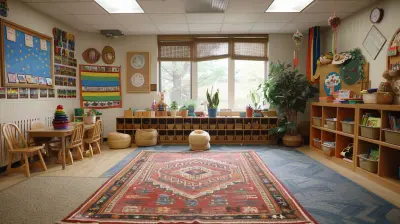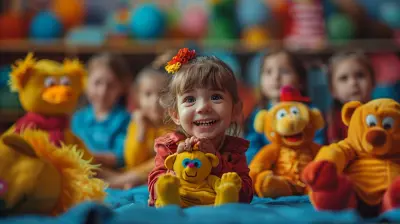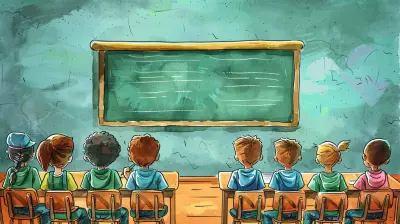11 October 2025
Reading is one of the most fundamental skills a child can develop, but let’s be honest—teaching it can sometimes feel like pulling teeth. Kids have short attention spans, and traditional methods, like flashcards and rote memorization, can make learning feel like a chore.
But what if we flipped the script and made reading an adventure? Picture a world where letters dance, sounds come alive, and stories turn into games. That’s the magic of playful learning! By introducing reading concepts through fun, engaging activities, we’re not just teaching kids to read—we’re helping them fall in love with the process.

Why Play-Based Learning Works
Kids naturally learn best through play. It stimulates their curiosity, encourages exploration, and reinforces concepts in a way that feels intuitive. When children engage in hands-on, interactive activities, they aren't just memorizing letters and sounds—they're experiencing them.Think about it: A child who builds a letter out of playdough isn't just recognizing its shape but also strengthening fine motor skills and memory retention. Playing a letter-matching game? That’s reinforcing phonics without them even realizing they’re "learning."
By incorporating play into early literacy education, we make reading feel less like a task and more like a joyful journey. 
Fun and Effective Ways to Introduce Reading Concepts
Ready to transform reading time into playtime? Here are some creative and engaging ways to introduce reading concepts through play.1. Storytelling with Props
Children love stories, and when they can interact with them, the experience becomes even more meaningful. Instead of just reading aloud, grab some props related to the story—a stuffed animal, toy car, or even a homemade puppet.Encourage your child to act out parts of the story, use silly voices, or predict what happens next. This not only enhances comprehension but also makes storytelling a dynamic learning experience.
2. Letter Treasure Hunts
Turn learning letters into a fun quest! Write different letters on sticky notes and hide them around the house. Give your child clues or a small map to find them.Once they discover a letter, challenge them to think of a word that starts with it. This simple game builds letter recognition and vocabulary without feeling like a lesson.
3. Phonics Hopscotch
Why sit at a desk when you can hop your way to phonics mastery? Draw a hopscotch grid and write different letters or simple words inside each square. As kids jump, have them say the sound or read the word aloud.This activity combines movement with learning, which is great for energetic learners. Plus, it's a sneaky way to build phonemic awareness while getting some exercise.
4. DIY Word Puzzles
Make reading a hands-on experience by creating your own word puzzles. Cut out pieces of paper shaped like puzzle pieces and write a letter or word on each one.Challenge your child to put the pieces together to spell words. This not only reinforces spelling but also improves problem-solving skills.
5. Sing and Rhyme Games
Songs and rhymes make reading concepts stick. Nursery rhymes, silly songs, and even made-up jingles help kids recognize patterns in language.Try creating songs using familiar tunes but swapping in new words that highlight phonics concepts. For example, instead of "Twinkle, Twinkle, Little Star," sing something like:
"Letter B goes buh-buh-buh, in the words we see and say!"
It may sound funny, but kids will remember it—guaranteed!
6. Magnetic Letter Challenge
A set of magnetic letters on the fridge can turn into an impromptu reading lesson. Ask kids to sort the letters by color, match uppercase and lowercase pairs, or spell simple words.You can also challenge them with fun tasks, like "Can you spell something you see in the kitchen?" This keeps learning spontaneous and enjoyable.
7. Story Dice Game
Make up stories on the fly with story dice! Create your own by drawing pictures or writing short words on different sides of a cube (or print out templates online).Roll the dice and encourage your child to come up with a sentence using the words or pictures that appear. This builds vocabulary, creativity, and a love for storytelling.
8. Sight Word Fishing
Cut out fish shapes from paper and write sight words on them. Attach a paperclip to each fish and create a fishing rod with a stick, string, and a magnet.Let kids "fish" for words and try reading them aloud. This activity turns sight word practice into an exciting game rather than a repetitive drill. 
The Science Behind Playful Learning
You might be wondering—does all this play actually help kids learn to read? The short answer: Absolutely!Boosts Engagement
When kids have fun, they’re more likely to stay engaged. Play keeps their brains active, making learning feel effortless.Builds Stronger Connections
Hands-on experiences create stronger neural pathways. A child who physically interacts with letters and words is more likely to remember them than one who just sees them on a page.Encourages a Growth Mindset
Through play, kids learn that mistakes aren’t failures—they’re part of the process. This fosters resilience, curiosity, and a positive attitude toward learning.Supports Multisensory Learning
When kids see, hear, touch, and say words, it reinforces learning. This whole-body approach is especially beneficial for children with different learning styles.
How to Make Play-Based Reading a Daily Habit
Now that you have a treasure trove of ideas, how do you fit them into your daily routine? Here are some simple tips:- Start small – You don’t need elaborate setups. Even five minutes of playful reading activities can make a difference.
- Follow their interests – If your child loves dinosaurs, create dino-themed letter games or read books about prehistoric creatures.
- Make it part of playtime – Integrate reading activities naturally instead of treating them like "lessons."
- Be flexible – Some days, kids will be more interested than others. That’s okay! Keep it light and fun.
Wrapping It Up
The road to reading success doesn’t have to be paved with tedious drills and frustration. By introducing reading concepts through playful experiences, we’re setting kids up for a lifetime of learning enjoyment.So, the next time you reach for a book, think beyond the pages. Add a game, sing a song, or set up a letter treasure hunt. Before you know it, reading won’t just be something they "have" to do—it’ll be something they want to do.
Because at the end of the day, the best way to teach reading is to make it come alive.








Zina McQuillan
Thank you for sharing these valuable insights! Introducing reading concepts through playful experiences is a wonderful approach to engage young learners and foster a love for literacy. Looking forward to more ideas!
November 5, 2025 at 11:57 AM